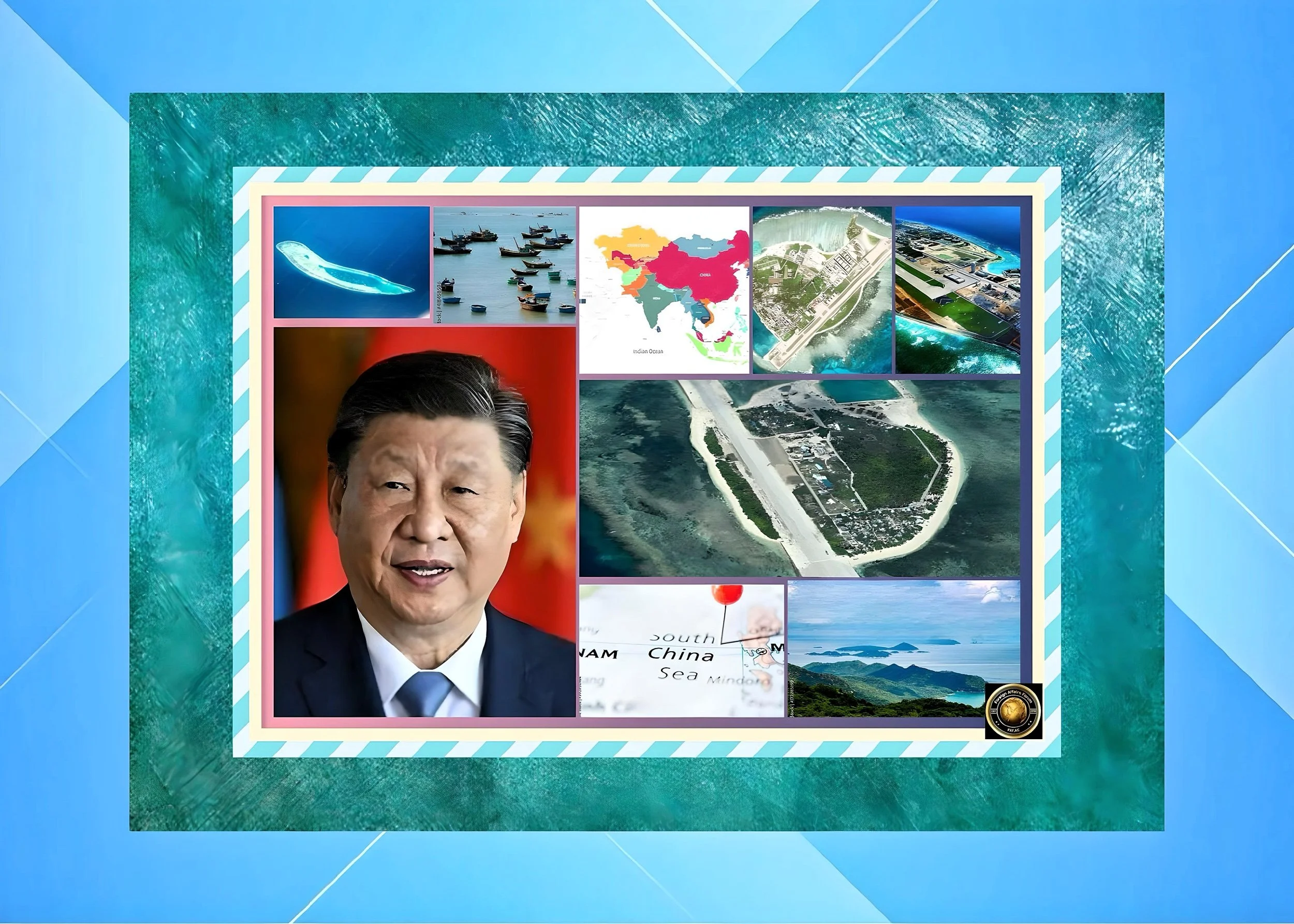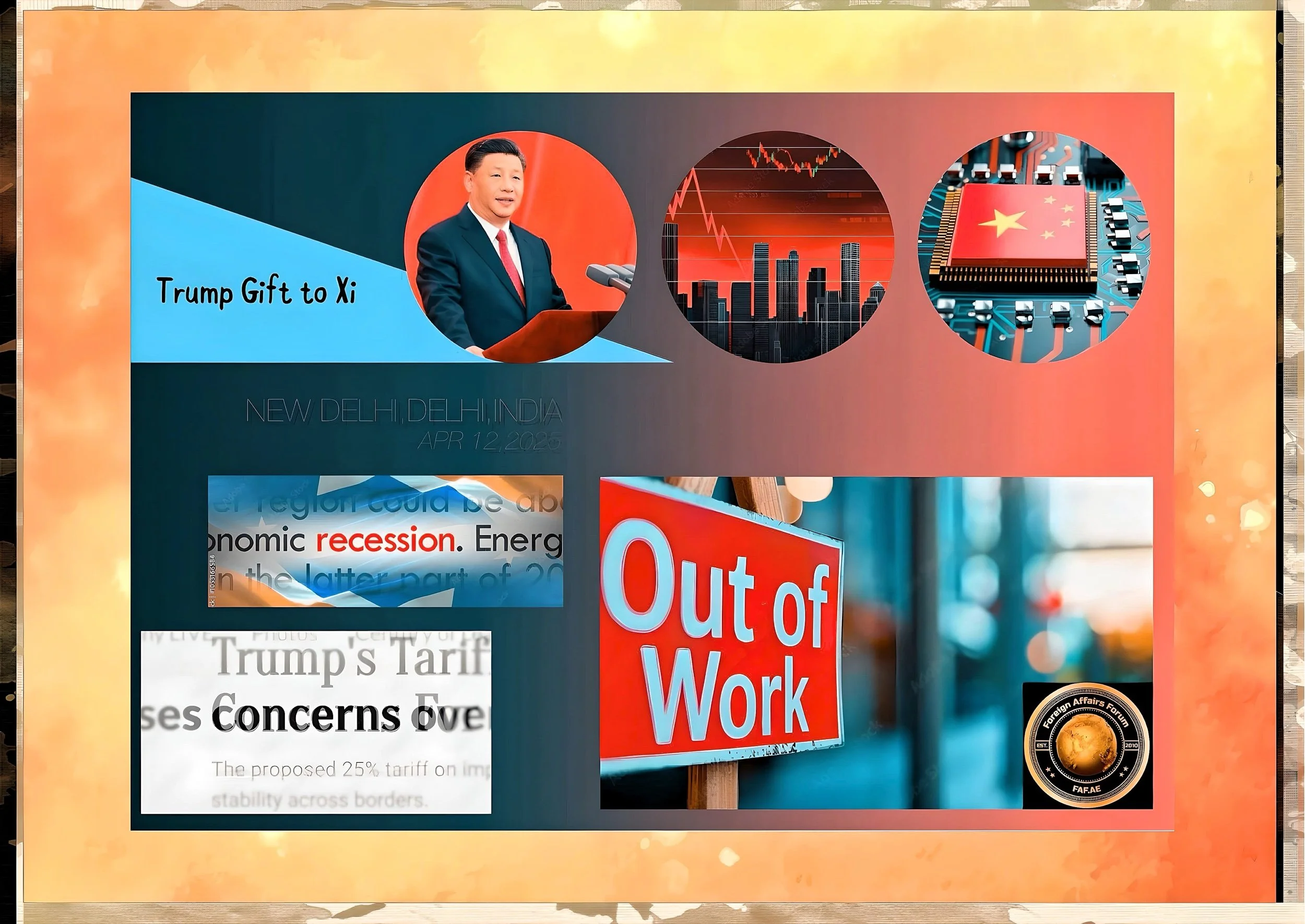China’s South China Sea Strategy: Assertion of Hegemony and Global Implications
Introduction
The South China Sea has emerged as one of the most contentious geopolitical flashpoints of the 21st century, with China’s expansive territorial claims and militarization efforts fundamentally reshaping regional dynamics.
Through historical revisionism, coercive diplomacy, and military posturing, Beijing has consolidated control over vast swathes of this critical maritime corridor, securing strategic advantages while undermining the interests of neighboring states and global powers.
FAF analyzes China’s calculated gambit in the South China Sea, its implications for international trade and security, and the Trump administration’s nuanced response to Beijing’s growing assertiveness.
Strategic Importance of the South China Sea
Economic and Military Foundations of Chinese Claims
The South China Sea is a linchpin for global commerce, with an estimated $3.36 trillion in trade transiting annually through its waters—equivalent to one-third of international maritime trade.
The region is particularly significant for China: 80% of its energy imports and 40% of total trade pass through these sea lanes, making their control vital to sustaining economic growth.
Beijing’s claims, demarcated by the controversial “nine-dash line,” encompass nearly 90% of the South China Sea and overlap with the exclusive economic zones (EEZs) of Vietnam, the Philippines, Malaysia, Brunei, and Indonesia.
China’s strategy combines historical narratives with modern power projection.
The Communist Party asserts sovereignty based on Ming Dynasty-era exploration records while constructing artificial islands equipped with military infrastructure.
Since 2014, China has reclaimed over 3,200 acres of Spratly and Paracel Islands land, installing radar systems, airstrips, and missile batteries.
This dual approach—leveraging historical claims while modernizing military capabilities—enables Beijing to dominate the region without immediate armed conflict.
Coercive Diplomacy and Regional Reactions
Beijing employs calibrated coercion to intimidate more minor claimants. Chinese coast guard vessels regularly harass Vietnamese and Philippine fishing boats, while “maritime militia” fleets blockade resource exploration activities.
In 2024, Vietnam reported 134 incidents of Chinese interference with its oil and gas surveys, culminating in snapped seismic cables and damaged equipment.
The Philippines faces similar pressures at the Second Thomas Shoal, where Chinese ships obstruct resupply missions to a grounded Philippine naval vessel.
These tactics align with China’s “active defense” doctrine, emphasizing preemptive actions to secure territorial interests while avoiding direct military confrontation with the United States.
By keeping confrontations below the threshold of open warfare, Beijing deters regional states from escalating disputes and discourages U.S. intervention.
Malaysia and Vietnam have responded with limited land reclamation projects, but their efforts pale against China’s scale: Vietnam added 134 hectares to its Spratly holdings in 2022–2023, compared to China’s 5 square miles of artificial islands by 2023.
China’s Strategic Advantages and Global Disruptions
Control of Critical Sea Lanes
China’s dominance over the South China Sea grants it unparalleled influence over Asia-Europe trade routes.
The Malacca Strait, through which 80% of China’s oil imports pass, becomes strategically redundant as Beijing develops alternative routes via the Spratly Islands.
By militarizing these outposts, China can potentially interdict rival nations’ shipping during conflicts, a capability underscored by its 2016 deployment of anti-ship missiles to Woody Island.
This control also strengthens China’s position in the Belt and Road Initiative (BRI).
Port investments like Cambodia’s Ream Naval Base and Myanmar’s Kyaukpyu Deep-Sea Port create a “string of pearls” that, combined with South China Sea bases, form an integrated network for power projects.
Regional states face economic coercion: when the Philippines challenged China’s claims in 2016, Beijing suspended banana imports, costing Manila $2.6 million daily.
Undermining International Law
Beijing has systematically ignored the 2016 Permanent Court of Arbitration ruling, which rejected China’s nine-dash line claims. Instead, It promotes bilateral negotiations that exploit power asymmetries with smaller neighbors.
Despite securing international legal victories, Vietnam and the Philippines lack the military capacity to enforce these rulings against Chinese coercion.
This legal erosion extends to freedom of navigation. Since 2015, China has restricted overflights and naval patrols near its artificial islands, violating the United Nations Convention on the Law of the Sea (UNCLOS).
While challenging these restrictions, the U.S. Freedom of Navigation Operations (FONOPs) have failed to deter Beijing’s incremental encroachments.
The Trump Administration’s Calculated Response
Strategic Ambiguity in the South China Sea
Contrary to perceptions of silence, the Trump administration has pursued a nuanced strategy balancing deterrence with economic pragmatism.
While continuing FONOPs, Trump has avoided direct military confrontations, strengthened alliances through arms sales to Taiwan, and participated in joint exercises with ASEAN navies.
This approach recognizes that open conflict over the South China Sea could jeopardize U.S. economic interests, given China’s role as America’s third-largest trading partner.
Economic levers are prominently featured in Trump’s strategy. The 2025 expansion of tariffs on Chinese goods, targeting sectors linked to South China Sea militarization (e.g., shipbuilding, steel), aims to constrain Beijing’s capabilities without military escalation.
Simultaneously, Trump has pressured ASEAN claimants to reduce economic dependence on China, offering alternative infrastructure investments through the Blue Dot Network.
Confrontation in the Red Sea: A Complementary Theater
The administration’s robust response to Chinese activities in the Red Sea reveals a broader containment strategy.
Since March 2025, Trump has ordered daily airstrikes against Houthi rebels in Yemen, explicitly linking their Iranian-backed attacks to Chinese support.
U.S. intelligence alleges that 90% of Houthi missile components originate from Chinese suppliers, while Chang Guang Satellite Technology—a PLA-linked firm—provides targeting imagery for attacks on commercial shipping.
By confronting China’s proxy warfare in the Red Sea, Trump seeks to counterbalance its South China Sea gains.
The administration’s public accusations against Beijing, including State Department condemnations of Chinese “complicity in terrorism,” mark a departure from prior administrations’ quiet diplomacy.
This dual-front approach pressures China while avoiding confrontation in the Indo-Pacific, where U.S. military superiority is less assured.
Implications for Global Order
Regional Hegemony and the “Beijing Lake” Ambition
China’s ultimate objective appears to be transforming the South China Sea into a “Beijing Lake”—a territorial waters analog to the U.S.-controlled Gulf of Mexico. Achieving this would grant China:
Energy Security
Control over 11 billion barrels of oil and 190 trillion cubic feet of natural gas reserves.
Military Dominance
Ability to project power across the first and second island chains, neutralizing U.S. bases in Guam and the Philippines.
Trade Leverage
Power to disrupt competitors’ economies by closing vital shipping lanes during disputes.
This hegemonic vision clashes with the U.S.-led liberal international order.
By rejecting multilateral dispute resolution and undermining UNCLOS, China erodes the rules-based system that has governed maritime affairs since 1945.
Regional states face a Hobbesian choice: accept Chinese dominance or risk economic retaliation and military coercion.
The Thucydides Trap and U.S.-China Rivalry
The South China Sea exemplifies the “Thucydides Trap,” where a rising power (China) challenges an established one (U.S.).
Beijing’s actions suggest a belief that America’s post-1945 naval supremacy is waning, creating opportunities to redraw regional boundaries.
Trump’s tariff policies and Red Sea interventions indicate recognition of this threat, but his administration’s avoidance of direct South China Sea confrontation reflects pragmatic limitations.
The strategic calculus hinges on nuclear deterrence. China’s 2025 atomic arsenal expansion—projected to reach 1,500 warheads by 2035—complicates U.S. intervention scenarios, as Beijing could threaten nuclear escalation over territorial disputes.
This mutual vulnerability incentivizes proxy conflicts (e.g., the Red Sea) while maintaining uneasy stability in core flashpoints like the South China Sea.
Conclusion
Navigating a Contested Seascape
China’s South China Sea gambit represents a masterclass in incremental hegemony-building. Through legal obfuscation, military modernization, and economic coercion, Beijing has established de facto control over one of the world’s most critical waterways.
The Trump administration’s response—combining Red Sea confrontations with South China Sea restraint—highlights the complexities of countering China’s asymmetrical strategies.
The international community's challenge is to uphold maritime law while avoiding conflict between great powers.
Strengthening ASEAN’s collective bargaining power, accelerating alternative trade routes (e.g., India-Middle East-Europe Economic Corridor), and leveraging economic sanctions against Chinese firms involved in militarization may offer non-military pathways to preserve open access.
Ultimately, the fate of the South China Sea will shape Asia’s geopolitical landscape and the viability of a rules-based global order in the 21st century.






